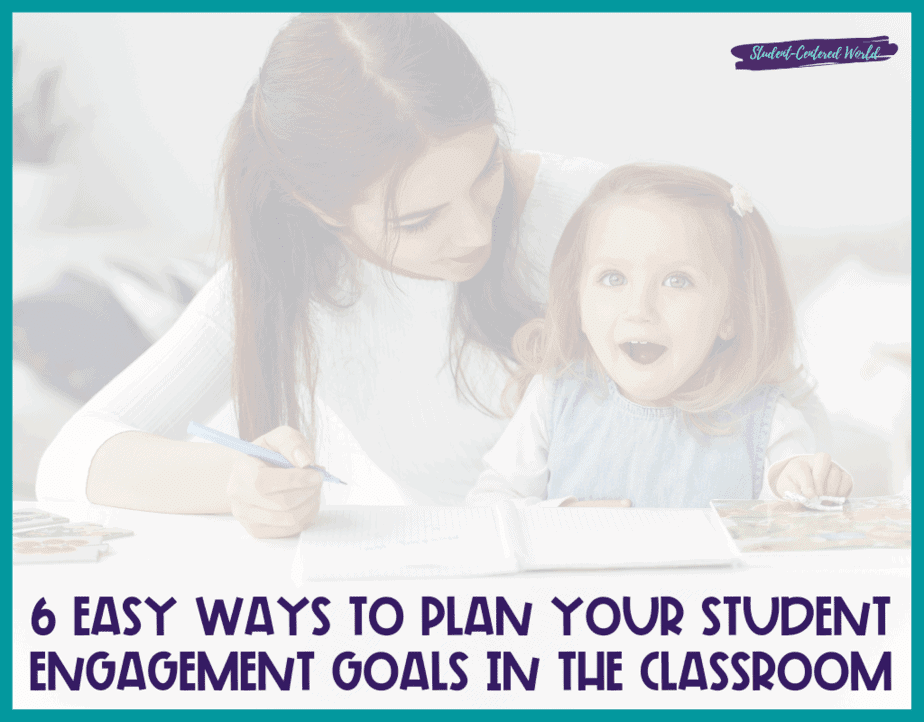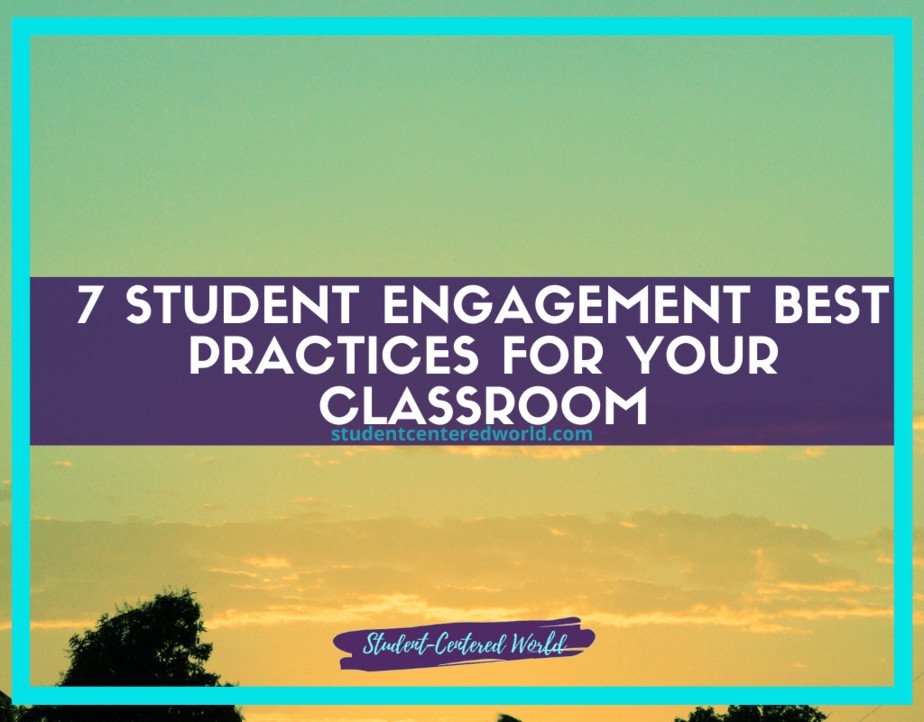6 Easy Ways to Plan Your Student Engagement Goals in the Classroom
I think all teachers have an idea of what their student engagement goals look like, but many think they’re either unreachable, unrealistic, or just generally aren’t sure how to get there. Reaching your student engagement goals takes a system, but once that system is part of your classroom culture and is understood by all stakeholders, it is much easier than you think. It doesn’t come naturally or easily, but it’s something that can be learned and mastered.
Defining Your Student Engagement Goals
As you begin to develop what the student engagement goals will be for your classroom, there are distinct questions you need to answer in order to really understand what your expectations need to be. These are questions like:
- What is your goal in creating a more engaging classroom?
- What area of student engagement is the most important one to you?
- Which of these areas do you need to work on in strengthening?
- How can you show your students that you love them and have high expectations for their behavior and learning?
- How can you be sure that they are respecting you and each other?
- How can you better establish your classroom as a respectful learning environment, both for yourself and your students?

These are questions to ask yourself in order to structure what high standards should look like in the classroom. Your student engagement goals should be directly linked to these definitive questions. Once you have them figured out, it will be much easier to see how they will play out in your classroom.
In order for student engagement to succeed, teachers need to get the students on board with the idea that learning is fun and that even when things get tough, it’s important that we all do our best! We want to make sure our students feel safe and respected, while also meeting or exceeding our high expectations.
The following four steps are the building blocks to achieving high engagement in your classroom: love, trust, respect, and expectations. Implementing these strategies will help you create a classroom environment where students want to be and feel accepted and comfortable. They make your job as a teacher much easier and help you create success in the lives of your students.
Love
Love sounds like such an odd concept, but it’s one of the most important parts of creating an engaged classroom community. This doesn’t mean that you need to love all your students; it simply means that each student needs to feel loved and supported. This is probably one of the most important pieces in creating and reaching your student engagement goals.
Teachers love to talk about the “softer stuff” like trust, respect, and expectations that are all important, but they tend to forget about love. Loving your students is imperative to creating an engaging classroom community because it helps each student feel safe and accepted. Love shows students that you care; it doesn’t mean giving kids free passes or always letting them off the hook when they misbehave. It means having high expectations for your student’s learning and behavior, but also understanding that each student is different and has different needs. When you love your students, you’re able to see past their misbehavior and into their hearts; this takes trust on both ends of the equation.
Trust
Trust is the next key building block in setting your student engagement goals. Trust means that students have to have faith in you as their teacher and believe that what you’re asking them to do (expectations) is for their benefit and will help them be more successful. It also means that you trust your students; they may not always make the “right” or most logical choice, but you trust that they’re making the choice that is best for them. Trust allows students to engage in the classroom and come into school feeling safe and supported by you as their teacher.
When teachers don’t have a foundation of love and trust with their students, it’s difficult to gain respect because students won’t want to follow your lead. Without trust, it will be difficult to gain respect because students won’t feel that you have their bests interests at heart. Trust is the first building block in creating a foundation for high student engagement.
Respect
Building on what was just said about trust, respecting your students is the next step towards achieving your student engagement goals. Respect means two things for teachers: respecting their students and having high expectations for their behavior. A teacher who doesn’t respect his/her students will have difficulty creating a culture of trust and support.
Respecting your students means that you are willing to see them as they are, not who you want them to be. You recognize that each student is unique with diverse interests, needs, strengths, and talents, but that they are also similar in their need to be respected. Expecting students to behave respectfully is one of the most important pieces in creating a culture where students feel safe and accepted.

Expectations
As I have said many times to the teachers I train, high expectations lead to higher achievement. It’s almost always true. When you have low expectations for students, they don’t rise to meet them and usually underperform because of this. It’s a sort of self-fulfilling prophecy; when we expect people to fail, it’s more likely that they will.
Expectations build on trust and respect to create high student engagement in the classroom. When you have high expectations for your students, they know that you believe in them and have faith in their ability to complete a task or behave a certain way.
Engagement is the goal of most teachers. How can we get our students actively participating in the classroom and learning? We all want our students to be engaged! No one wants students to be bored. But how do we create an engaging classroom community where students want to engage?
Creating a culture where love, trust, respect, and high expectations lead towards high student engagement starts with the teacher and is mirrored by the students as they engage both individually and collectively in learning activities. When we all work together, we can create something beautiful in the classroom.
Putting Your Student Engagement Goals into Practice
When you are setting your student engagement goals, remember what it takes to create a culture where students feel loved, respected, trusted, and have high expectations for themselves. Be proactive in your classroom community by fostering the right relationships with students. What will that look like in your classroom? How can you keep track of the attempts to integrate this into your classroom culture to see what’s working and what needs to be tweaked?

I have included below some ideas for things you can do in your classroom to build this culture. Don’t try all of them, but pick a few that are good fits for your students and teaching style:
- Create community bulletin boards using student work and samples of student writing. These will help students see they are part of a larger community and that they each have a voice in the classroom.
- Create an authentic audience using photos of your students, their families, and friends. This will show them how others care about what they do in school and will help build trust with your students.
- Enforce daily routine so that students know exactly what to expect every day. Routines create security, especially for students who are new to your classroom or school.
- Use discipline strategies that build trust and respect instead of breaking them down. Teachers sometimes use punitive forms of discipline in an attempt to gain respect, but they actually do more harm than good when they go against the foundation you are trying to build with students.
- Do not talk about students as numbers or assign “grades” before you know your students. I understand that standardized curriculums require these types of assessments, but try not to think of them as grades. Instead, create a narrative assessment for each student using samples of their work and other pieces from throughout the year so you can see what they have learned instead of what they can do.
- Be clear about your expectations and the consequences that come if those expectations are not met. Make sure you communicate with students how they can be successful in meeting your expectations so they feel empowered to do so.
- If a student is struggling, be proactive instead of reactive by identifying the teaching point first. What struggles are preventing them from engaging in the classroom? Make sure you are aware of their strengths as well so they can be successful.
- Do not wait for students to make a mistake before offering help. Instead, watch them closely for signs that they are struggling or could use your assistance on something specific.
- Give students choice whenever possible because it will allow them to have some level of power in their learning which will empower them to be engaged.
- Focus on the positive! Catch students doing something good and point it out to your class. You can even create a bank of things that went well during lessons to use throughout the year, not just at report card time. This will show students how much you care about their success and it will make it so much easier to reach those student engagement goals.
Stop Driving the Teacher Struggle Bus
Are you struggling with student engagement, apathy, or keeping your class on track?
💫💫 There’s hope! 💫💫
Join my free teacher workshop “Choosing Choice” and in just 60 minutes, you’ll craft a practical plan to revitalize your teaching. Discover the magic of student choice in boosting engagement, gain quick implementation ideas, and explore strategies for year-long success.
Unlike overwhelming workshops, my approach guides you in real-time, providing more classroom options, reducing stress, and giving you more personal time.
Plus, you’ll earn a 1-hour professional development certificate and have 7 days of access.
Don’t miss this chance to transform your teaching; click below to secure your spot now!






